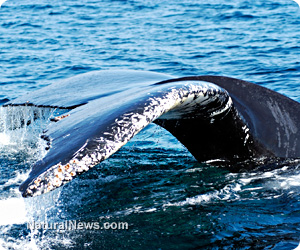
- European Court of Justice: Healthcare professionals who promoted or administered COVID-19 vaccines are CRIMINALLY LIABLE for any harm caused
- Oncologist warns of ‘terrifyingly aggressive’ cancers in children, linked to immune suppression from COVID vaccines
- Newly released JFK files reveal Pentagon's role in creating Lyme disease and covid in the same lab
- Ancient kitchen secrets REVEALED: How garlic, ginger and green onions fight cancer and heart disease
- Britain’s descent into police state censorship: Parents raided for questioning their daughter’s school system online
- NIH study, buried for decades, reveals that Flu Shots INCREASE elderly deaths, not prevent them
- COVID-19 scandal linked to CANCER SURGE: Billionaire researcher sounds alarm
- DARPA: The shadowy innovator behind the world’s most advanced military technologies
- Decentralize TV: Dr. Leonard Coldwell reveals shocking, heavily censored truths about CANCER, healing and the medical mafia complex
- “Old Man in a Chair”: The COVID-19 pandemic was a carefully orchestrated scheme for global control
- Musk targets “strangely wealthy” lawmakers in DOGE probe, names Pelosi, McConnell, Schumer
- RFK Jr. is reforming Americans’ health: A shift in power and paradigm
- Cinnamon plays a critical role in diabetes management
- Utah governor allows ban on LGBT pride flags in public buildings and schools, will take effect without his signature
- FRAUD ALERT: Details DEMOCRATS do NOT want you to know about the $40 BILLION wasted on Fed-loaded credit cards cancelled by DOGE
- Scientists unveil breakthrough method to eliminate "Forever Chemicals" from water, transforming waste into graphene
- RFK Jr. is pushing Big Pharma ad ban - and corporate media is panicking
- Pam Bondi promises ‘NO PLEA DEALS’ in Tesla vandalism cases - MAXIMUM PRISON TIME to be served for Dems and Libs’ freakshow violence against the Right
- Newly released JFK files reveal Pentagon's role in creating Lyme disease and covid in the same lab
- CDC finally halts $11 billion COVID funding scam as health officials admit the ‘pandemic’ was a fraud
- Analysis: The coming economic collapse, a mass uprising and Trump's three secret weapons to halt the growing revolt
- Kiss Your Genetic Privacy Good-Bye! 23andMe Gets Green Light to Sell Your Intimate Genetic Details to Anyone They Want
- Dr. Suzanne Humphries makes bombshell appearance on Joe Rogan podcast, exposing vaccine industry deception back to POLIOMYELITIS
- DEADLY DECEPTION: How COVID vaccines increased mortality rates and why authorities hid the truth
- Woman contracts WORLD'S DEADLIEST VIRUS after unknowingly being given the WRONG VACCINE
- Oncologist warns of ‘terrifyingly aggressive’ cancers in children, linked to immune suppression from COVID vaccines
- Here are TEN all-natural ways to protect your garden without using harmful chemicals
- Black cumin seed oil emerges as a powerful ally against breast cancer and chronic inflammation
- The hidden dangers in your kitchen: How cooking methods impact diabetes, cancer and aging
- Trump's greatest betrayal so far: Accelerating Middle East wars, silencing dissent, and serving Zionist masters
- Senate Democrats deny censorship industrial complex existed, defend government's role in silencing dissent
- Sugar-free deception: Artificial sweeteners hijack hunger signals, fuel obesity epidemic, study warns
- “Independent” anti-Russia outlet MEDUZA faces COLLAPSE as US funding dries up
- NIH study, buried for decades, reveals that Flu Shots INCREASE elderly deaths, not prevent them
- The Health Ranger releases “Vaccine Zombie” song and music video, using AI-animated zombies for the music video
- Discovery of vast underground city beneath Giza pyramids challenges human history
- Newly released JFK files reveal Pentagon's role in creating Lyme disease and covid in the same lab
- California's social media censorship law struck down: A victory for free speech or a threat to online safety?
- EPA advisor admits the agency is funneling billions to climate groups ahead of Trump’s return to White House
- The Health Ranger releases “Vaccine Zombie” song and music video, using AI-animated zombies for the music video
- Dr. Mike Yeadon releases 15-minute testimony - WATCH - about genocidal intent of COVID “vaccines”
- Florida takes a stand: DeSantis proposes permanent ban on mRNA vaccine mandates
- Mike Adams releases country western hit single: Goin’ Back in Time is Comin’ Home
- “Why we influenced the 2020 elections”: Facebook files reveal the coordinated effort to bury the Hunter Biden laptop story
- Unpacking the Lies That We’ve Been Fed – new song and music video released by Mike Adams, the Health Ranger
- House Intelligence Committee calls for the ARREST and PROSECUTION of Dr. Anthony Fauci
- The pandemic as a tool for INDOCTRINATION: Understanding “The Indoctrinated Brain” by Dr. Michael Nehls
- Rep. Nancy Mace introduces bill to ban biological males from female facilities on federal property
- Mike Adams releases music poetry sensation: A Child of God
- Sugarcane extract superior to cholesterol-lowering drugs?
- Survival 101: Effective EMF blocking techniques
- Michigan sheriff announces criminal investigation into 2020 election crimes, Dominion Voting Systems
- Peter Rost exposes Big Pharma corruption in his book “The Whistleblower: Confessions of a Healthcare Hitman”
- Migrants are taking advantage of recent hurricanes to scam residents and loot their homes
- Red Cross issues warning to stop blood plasma donations from vaccinated people
- Scientists confirm: GENIUS brain function can be spontaneously unleashed in humans without any apparent cause
- EPA advisor admits the agency is funneling billions to climate groups ahead of Trump’s return to White House
- HYSSOP: What research reveals about the health benefits of this ancient holy herb
- Two containers with completed ballots fall out of truck in Florida
- Fully vaccinated about to see “tsunami” of illness and death, warns virologist
- Global leaders unite to clamp down on “misinformation” with UN-backed Cascais Declaration
- BREAKING: 2025 NDAA authorizes mandatory military draft of WOMEN across America… as Pentagon pursues global NUCLEAR war with both Russia and China at the same time
- Michael Yon warns of a ZIONIST TAKEOVER in Trump’s second administration
- BOMBSHELL: DNA testing kits are a SCAM to develop ethnic-specific bioweapons
- Ozempic and Wegovy weight loss drugs are injectable LIZARD VENOM PEPTIDES that may unleash a devastating wave of organ failure… side effects align with symptoms of SNAKE BITES
- Israeli soldiers accused of even more torture and abuse in the West Bank
- These 13 countries just signed an agreement to engineer a global FAMINE by destroying food supply
- NASA admits that climate change occurs because of changes in Earth’s solar orbit, and NOT because of SUVs and fossil fuels
- RFK Jr. clears key hurdle: Sen. Susan Collins backs controversial HHS nominee, signaling a new era for health policy
- Sermon 30: How Jesus reveals Caesar’s FAKE CURRENCY and FALSE AUTHORITY
- Coriander seeds: Ancient medicine backed by modern science
- Arizona officials claim Maricopa County needs 10-13 days to tabulate results of the election
But so do the sonar capabilities of dolphins and other sea creatures, according to researchers who have recently revealed the fossilized skull of a 28-million-year-old marine mammal that also used sound to find its next meal or safely navigate muddied waters.
The animal, known as Cotylocara macei, is the earliest known cetacean that has skeletal evidence indicating some natural form of sonar, says the research team which reported its findings in the journal Nature.
As reported by The Christian Science Monitor:
After comparing the nearly complete skull with those of other fossil cetaceans, the team placed C. macei on the evolutionary tree just above the common ancestor to all toothed cetaceans. That branch of the whale family uses echolocation to find its food, unlike their cousins who feed by straining seawater through boney baleen plates. Right and humpback whales are modern examples of these strainers.
The study's findings establish "an important new piece of information on when echolocation originated, such that it originated almost immediately after the split between baleen whales and toothed whales," Frants Jensen, a researcher at the Woods Hole Oceanographic Institution in Woods Hole, Mass., who studies marine echolocation, said.
It's all in the clicks
For some time, researchers have shown an interest in the evolution of natural sonar, known as echolocation, in marine mammals because of the complexity involved in finding food or getting around in dark ocean waters.
Scientists know that sperm whales, which are the largest toothed whales on Earth, echolocate by emitting widely spaced sharp clicks; it sounds a lot like hitting two spoons together.
Some researchers say they have noticed that each whale appears to have its own unique rhythm, which allows it to distinguish its own sounds from those of other whales. Dolphins, by comparison, echolocate by emitting tightly-spaced clicks that sound a lot like a creaky door when it is opened.
Pitch and timing of a sea mammal's sonar is very often tailored to its surroundings, scientists say. Dolphins inhabiting harbor regions, for example, tend to use a frequency that "falls within a narrow window of relative silence amid the clutter of underwater noises in a harbor," CS Monitor reported.
New York Institute of Technology researcher Johnathan Geisler and two colleagues have discovered a new lane of early evolution among early toothed cetaceans with this capability with the newly described C. macei.
Interestingly, the skull was unearthed from a drainage ditch which forms one boundary of a housing development in College Park, S.C.
The developments were first constructed in the 1970s; as drainage ditches were built, "they hit this really rich, muddy sand that's produced a huge number of fossil cetaceans," Geisler said. "You never know what you'll find in your backyard."
'Modern' sonar developed around turn of 20th century
There have been many fossil discoveries there, but so far only a few of them have been formally described. The skull analyzed by Geisler and his team came from that collection, which is stored at the Mace Brown Natural History Museum at the College of Charleston.
Certain aspects of the skull got Geisler's attention.
"Cetaceans have very strange skulls, particularly the toothed whales, dolphins, and porpoises," he said.
Adds CS Monitor:
Many of the bones associated with the snouts, or rostrum, extend back to cover much of the skull -- a feature known as telescoping. It's a feature that becomes more pronounced as ancient lineages of toothed cetaceans evolved into today's animals.
The newly described skull shows a degree of telescoping usually seen in today's cetaceans, he continues. And it isn't seen in other members of the extinct family to which this species belongs.
"There were a lot of enigmas with this specimen," he says.
If the C. macei was able to use sonar, that means that the capability first evolved in toothed cetaceans between 32 and 35 million years ago, said the researchers.
Meanwhile, modern sonar was first developed as a submarine-detection device in 1906 by Lewis Nixon, as a way of detecting icebergs.
Sources:
http://www.csmonitor.com
http://inventors.about.com
http://www.reuters.com
http://science.naturalnews.com
Sonar at FETCH.news
Get independent news alerts on natural cures, food lab tests, cannabis medicine, science, robotics, drones, privacy and more.
Take Action: Support Natural News by linking to this article from your website
Permalink to this article:
Embed article link: (copy HTML code below):
Reprinting this article:
Non-commercial use OK, cite NaturalNews.com with clickable link.
Follow Natural News on Facebook, Twitter, Google Plus, and Pinterest
Science News & Studies
Medicine News and Information
Food News & Studies
Health News & Studies
Herbs News & Information
Pollution News & Studies
Cancer News & Studies
Climate News & Studies
Survival News & Information
Gear News & Information
News covering technology, stocks, hackers, and more



"Big Tech and mainstream media are constantly trying to silence the independent voices that dare to bring you the truth about toxic food ingredients, dangerous medications and the failed, fraudulent science of the profit-driven medical establishment.
Email is one of the best ways to make sure you stay informed, without the censorship of the tech giants (Google, Apple, Facebook, Twitter, YouTube, etc.). Stay informed and you'll even likely learn information that may help save your own life."
–The Health Ranger, Mike Adams













































